De um querido irmão Tuga, uma contribuição de grande valor:
Pessoal, para vcs que são experts na parte de caças deixo aqui este artigo, gostava de saber as vossas opiniões de sábios!!!!!
.......
Australian Committee Hearing Reveals Details of F-35 Performance in Wargame
(Source: Defense-Aerospace.com; posted March 6, 2012)
PARIS --- The Australian Parliament’s Joint Committee on Foreign Affairs, Defence and Trade has just released a transcript of a Feb. 7, 2012 hearing during which it took evidence on the F-35 program by noted opponents of the program, representing the Air Power Australia think-tank and a private computer simulation firm, RepSim Pty Ltd.
Part of the hearing describes the outcome of a famous – but disputed – simulation of F-18E and F-35 fighters engaging in combat against Chinese air force fighters carried out by the Rand Corporation. The outcome is even more disastrous for the Western fighters than previously reported.
A link to the full transcript of the hearing is provided at bottom.
Mr Christopher Laurie Mills, Director, RepSim Pty Ltd:
(…/…) So we set up the scenarios that RAND Corporation had been asked to examine, which was mass attacks of Chinese fighters and response by Super Hornet and F35. For example—and I have the video here but is too long to show the committee—we had 24 on 24 with the Western side supported by tankers and AWAC aircraft—airborne early and warning control.
We sent out 240 F35As against the C35S, which is not as powerful as the PAK FA, and 30 came back—out of 240.
We sent out 240 Hornets and not a single Hornet came back.
We sent out 240 F22s—139 came back, and only 33 Sukhois came back.
These results have been compared with a rare public disclosure and they show that the model is scaled correctly. It is putting it in the right order. You would not expect an F35 to be able to take on an advanced fighter like the C35. Its correct nomenclature should not be F35; it should be A35. It is an attack aircraft. To reinvent it as an air superiority weapon is a complete mistake. It is not.
The F22 was designed for air superiority and air dominance. It was designed to be there to support the A35 with the sorts of things that Dr Kopp and Mr Goon have been talking about.
It is pretty serious stuff when you send out 240 aeroplanes and only 30 come back—I must emphasise, using the same but superior model that we were using to do much the same work inside Defence linearly.
CHAIR: With respect to your simulation exercise in that example, where fewer came back, did you incorporate in that exercise ground support and any other factor that might complement that particular war game?
Mr Price: They were sitting over the ocean off Taiwan. This is the simulation required by RAND. The Super Hornets had come off carriers and come out of Okinawa. The confrontation was mainly to the north of Taiwan. The only requirement that RAND had that must be met in terms of developing a situation was its hypothesis that in 2018 the Chinese would have developed high frequency over-the-horizon radar which would defeat the stealth characteristics of both the F22 and the F35.
The Super Hornet has got no stealth at all. At the end of the day, it is a technological lemon for a modern air-to-air combat aircraft. It has got one speed, so it will fall out of the sky as soon as you shoot it.
The issue for the other two was that they had stealth, which in the endgame may reduce the attrition based upon an ability to defeat the weapons, because there it is not aircraft on aircraft but weapon on aircraft. The issue for us was to develop a simulation such that it represented what the environment would be like should the Chinese be able to provide targeting information at the course level to attacking aircraft that would enable them to use sensors other than radar to detect and engage the F22 and the F35.
In combat, the back end of the F35 on afterburner is something like 1600 degrees Fahrenheit. In terms of temperature, aluminium combusts at 1100. You are talking about something really, really hot. If you have got a dirty big sensor on the front of your SU35 or your PAK FA or whatever, it lights up like Christmas lights and there is nothing you can do about it. And the plume, because of the symmetric exhaust, is all over the place. It is not shielded, it is not ducted in any useful way. So from an IRUV point of view, the advantage that the Russians, Chinese, Indians, you name it, can have is that they have a range of different seeker types on their weapons that can engage the aircraft.
We are basically limited to medium range with one type of technology. Short range we have an IR missile, the Sidewinder or the ASRAAM, but at the end of the day you cannot get into a position to fire the thing before you are shot by the adversary's weapons. That was the outcome of the analysis of the exercise.
CHAIR: Just to clarify this, essentially it was an aircraft-on-aircraft exercise? With no support of the—
Mr Price : We had four AWACs in support. They were the first things targeted by the SU35s in the engagement. They had a life expectancy of about 17 minutes. Mind you, that is eight minutes better than what they have got in Europe.
Then it came to the tankers. The tankers were all rolled up, but they generally got rolled up after the fighters had been engaged. The issue for the F35 in particular, was that because the aircraft is aerodynamically poor it is not able to engage very fast leakers that can get through a screen and take out the AWACs and your tankers. Once you take out the AWACs or the tanker—the JSF at its full capacity is burning something like 3.38 kilos of fuel per second—unless you have a flying gas station behind you, going into high-end combat an F35 has a very short time span activity.
Mr Goon : Are you referring to what is referred to as the 'systems with systems' approach to air combat?
CHAIR: No, what I am referring to is that there is no normal war game. There is always additional activities and capabilities used in an attack on your enemy. I am asking, in the example that was provided by Mr Mills in that particular exercise, about what was factored in—was sea support, or whatever the case might be, from an aircraft carrier and those sorts of things, or land missiles, in respect to being involved in the particular exercise to eliminate one another?
Mr Mills: There were actually land missiles on Taiwan-Patriots—and there were HQ9s and SA20s on the Chinese mainland. Every now and again you would see an aircraft chasing a Sukhoi back to the base and being lost through the SAMS. There were Chinese HF radars providing functions something like our JORN there. In fact we tried to make it a clean aircraft-on-aircraft environment but we also had to make it realistic.
So we had to array all the forces. So you had every element that was on Kadena. You had a carrier task group there providing communication support and every now and again you would see a fight over Taiwan and something would get lost in there because they had SAMS. So, yes, it was a full environment but we deliberately set it up because RAN's interest—their scenario—was: what happens when you get massed aircraft on massed aircraft? That was what we were focusing on.
If you want to talk about the things that Dr Kopp is talking about, that is very straightforward. We have got all of the missile systems modelled, and if you want to see how an F35 would perform against a modern SA20, 21, 22, 23 type of environment that would be very straightforward.
…/…
Senator JOHNSTON: We can go on like this for a while, Chair. I think the committee would really appreciate, Mr Price, if you could list the assumptions that were made with respect to this engagement. I think it would be very helpful for the members to understand exactly, because they can read the RAND report—that is a public document—and they can see what you have done and that will give—
Mr Price : No, sorry; you will not read a RAND report of that activity. That activity was done separately to the Pacific Vision war game, and the analyst who did that was subsequently released from RAND because it never existed. (end of excerpt)
Click here for the full transcript, on the committee’s website.
http://parlinfo.aph.gov.au/parlInfo/sea ... %2F0000%22
fonte:
http://www.defense-aerospace.com/articl ... rgame.html








